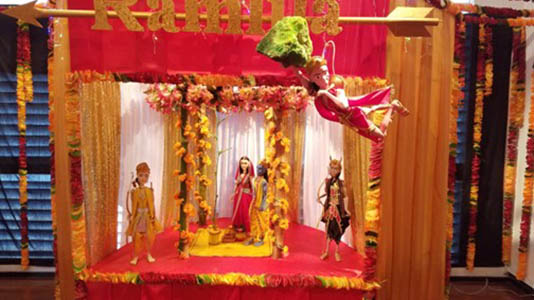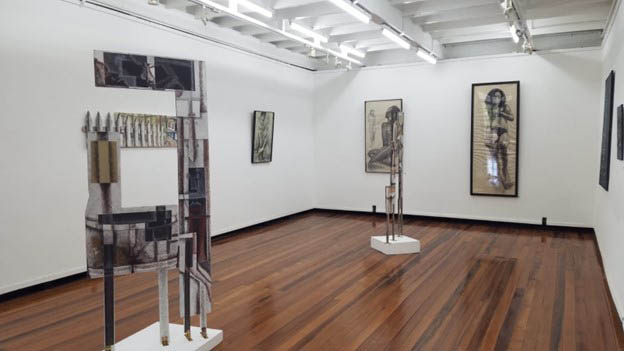On Monday, October 16, the National Gallery of Art (NGA) Castellani House along with the Faculty of Education and Humanities of the University of Guyana hosted the opening of “Musings, Guyanese Folktales, and Figures of the Ramlila”, an art exhibition featuring works from the two prospective graduates of the university’s BA in Fine Art Programme, current students, recent alumni, and two lecturers of the Division of Creative Arts (DCA). The exhibition features approximately 40 works, mostly paintings, and a substantial room transformation.
Musings follows the DCA’s last exhibition, “The Seven Orishas and the Scarlet Thread”, which was also mounted at the NGA, in late 2022. Then the two young artists of the recently graduated Class of 2022 showed their work alone, with their final-year project taking prominence. Thus, while the closures precipitated by Covid affected art training negatively, the DCA was able to meet the challenges with sufficient success to be able to host back-to-back art exhibitions of students’ work.

Now, it may be expected that in writing about this exhibition I will offer a kind of review. I will not. I am unwilling to do so as I was substantially involved in organising the exhibition. Thus, I will not use this space to offer any perspective of how the job of exhibition-making was done. I have seen this done many times – organisers reviewing their own work in the media with sufficient biased commendation that I lost interest in reading. I will not partake. I will leave you to decide whether the exhibition layout and supporting paraphernalia met your expectations and reflected the perspectives offered by me in previous articles. It is also for you to decide whether the DCA is doing a good or a poor job in what you understand it should be doing.
What I can offer, however, is a synopsis of the themes explored in the exhibition and some insight into the layout of the works. It should be recognised that the prospective graduates are Daniel Diaram and Vishnu Mahadeo; the recent alumni are Ohene Koama, Douglas McKenzie, Keisha Pilgrim, and Oliver Smith; and the current students are Aubrey Alves, Tahirih Gerrard, Rouchelle Stephens, and Lisa Williams. The two lecturers are Elodie Cage-Smith and Philbert Gajadhar, both of whom are alumni of the DCA, although decades apart.
While the exhibition overview in the catalogue offers insight into the themes of the exhibiting artists it may be as useful to take a tour with words. Here goes: Having climbed the flight of stairs, one’s approach to the main gallery on the middle flat of the NGA is accompanied by six chromatically rich paintings by Gajadhar which also flank the entry to the small gallery on the left. This small gallery has been transformed into a space reminiscent of a Hindu marriage ceremony. The major work to be experienced is ‘5 Figures of the Ramlila’. Mahadeo explains that four of the five figures are in positions that represent the wedding ceremony from the drama, the Ramlila. The figures represented are Shri Rama in blue, Maa Sita the singular female figure, Laxmana in yellow, and Ravana (the Demon King) in black. He further explains that the suspended figure represents Hanuman who is flying back to Lanka with a mountain in his hand. In the room are two sculptural works. The more impressive of the two is associated with Lord Vishnu who appeared on earth at different times for different purposes. Mahadeo explains that the fourth time Lord Vishnu came he did so as Lord Narsingha in the form of “a half-man half-lion [with] claws” – a ferocious character, while the bow (the Pinaka) relates to Lord Vishnu’s appearance as Shri Rama who was a calm and humble character and who needed to break the bow to win the hand of Maa Sita in marriage.

Entering the main gallery from the main entrance, one is met with very restive flowers in Pilgrim’s ‘Red Hibiscus’ and to its left the harmonising hues of McKenzie’s music-themed painting explorations. To the right, at the end of the gallery’s long rectangular space are Koama’s two ‘drawings in the round’ which are delightful sculptural articulations and a differently themed drawing in relief. Adjacent to these, one is met with Smith’s three large charcoal drawings of women who simultaneously present and hide their bodies. These figures echo the simultaneity of disguise and reveal in Koama’s work.
As one moves within this area of the gallery clockwise, one is met by Cage-Smith’s paintings which relate to the theme of disguise in the drawings, while also relating to the vexing themes of Gerrard’s works which are adjacent to them. Gerrard’s ideas are beautifully and bluntly articulated in two intimately scaled paintings. For instance, ‘The Black Pawn’ is a clear articulation of concern for the historical and contemporary socio-cultural treatment of the black woman’s body. Meanwhile, her painting ‘Maternal Love’ offers another counterpoint to the aforementioned efforts of disguise and reveal by being very direct in imagining black maternal love, a powerful corrective for the historical denigration of black mothering in the West.
Continuing clockwise, one sees female bodies that Stephens has wrapped in surreal-appearing visualisations as more floral imagery appears in one’s peripheral view alongside a scene of boats docked by Williams. Venturing behind the display screen where Stephens’ provocatively titled ‘Reflections Sometimes Come as a Surprise’ is hung, one is met by echoes of far-off places in Alves’ ‘Gods and Goddesses’ and ‘Beauty and Pride’. But one is soon pulled away from Alves’s call for reverie by Stephen’s larger-than-life-sized painting of a woman holding a diminutive standing man in her hand. Although Stephen’s ‘Woman’ may attempt to confront the subordination of women in our historical and cultural spaces, the work has echoes of myth (and to theory of a Neolithic matriarchal past). ‘Woman’ is thus loosely thematically linked to Diaram’s ‘Folklores of Guyana Reimagined’. Diaram’s images which are computer-generated offer a youthful perspective of the Guyanese myths many of us heard as children and which bring back fond memories of storytelling on blackout or moonlight nights.
As eclectic a cultural space as Guyana is, so too are the offerings of “Musings, Guyanese Folktales, and Figures of the Ramlila”, which closes on October 28.




